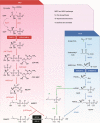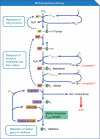Review article: inhibition of methanogenic archaea by statins as a targeted management strategy for constipation and related disorders
- PMID: 26559904
- PMCID: PMC4737270
- DOI: 10.1111/apt.13469
Review article: inhibition of methanogenic archaea by statins as a targeted management strategy for constipation and related disorders
Abstract
Background: Observational studies show a strong association between delayed intestinal transit and the production of methane. Experimental data suggest a direct inhibitory activity of methane on the colonic and ileal smooth muscle and a possible role for methane as a gasotransmitter. Archaea are the only confirmed biological sources of methane in nature and Methanobrevibacter smithii is the predominant methanogen in the human intestine.
Aim: To review the biosynthesis and composition of archaeal cell membranes, archaeal methanogenesis and the mechanism of action of statins in this context.
Methods: Narrative review of the literature.
Results: Statins can inhibit archaeal cell membrane biosynthesis without affecting bacterial numbers as demonstrated in livestock and humans. This opens the possibility of a therapeutic intervention that targets a specific aetiological factor of constipation while protecting the intestinal microbiome. While it is generally believed that statins inhibit methane production via their effect on cell membrane biosynthesis, mediated by inhibition of the HMG-CoA reductase, there is accumulating evidence for an alternative or additional mechanism of action where statins inhibit methanogenesis directly. It appears that this other mechanism may predominate when the lactone form of statins, particularly lovastatin lactone, is administered.
Conclusions: Clinical development appears promising. A phase 2 clinical trial is currently in progress that evaluates the effect of lovastatin lactone on methanogenesis and symptoms in patients with irritable bowel syndrome with constipation. The review concludes with an outlook for the future and subsequent work that needs to be done.
© 2015 The Authors. Alimentary Pharmacology & Therapeutics published by John Wiley & Sons Ltd.
Figures






References
-
- Caetano‐Anollés G, Kim KM. The origin and evolution of the Archaeal domain. Archaea 2014; 2014: doi:10.1155/2014/915828 [Epub ahead of print] - DOI - PMC - PubMed
-
- Pimentel M, Lin HC, Enayati P, et al Methane, a gas produced by enteric bacteria, slows intestinal transit and augments small intestinal contractile activity. Am J Physiol ‐ Gastrointest Liver Physiol 2006; 290: G1089–95. - PubMed
Publication types
MeSH terms
Substances
LinkOut - more resources
Full Text Sources
Other Literature Sources
Medical
Molecular Biology Databases
